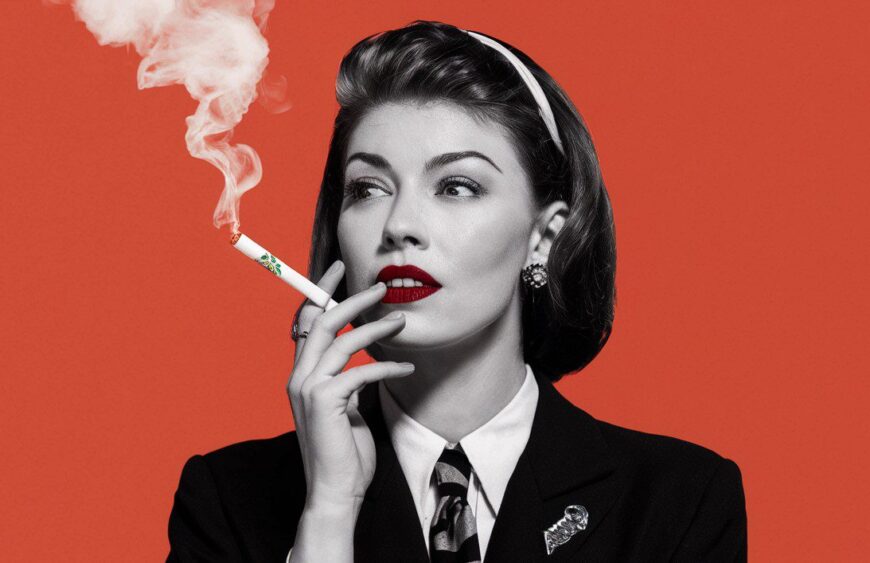Explore the distinctive smoking culture that thrived during the 1960s, characterized by an aura of rebellion and social change. From smoky jazz clubs to bustling coffeehouses, cigarettes were more than just a habit—they were a symbol of freedom and self-expression. Dive into the enchanting world of 60s smoking, where iconic figures like Audrey Hepburn and James Dean epitomized sophistication with every puff.
This article delves into the captivating allure of smoking in the 1960s, shedding light on the prominent cigarette brands and their role in shaping popular culture. However, it’s essential to recognize that our understanding of smoking and its health implications has evolved significantly since then. We do not advocate for smoking but rather aim to paint a vivid picture of an era where cigarettes were intertwined with the fabric of society.
So, buckle up and prepare to journey back in time to an era of cultural revolution and smoking chic. Join us as we unravel the mystique of the unique smoking culture that defined the swinging 60s.
The Emergence of Smoking During the 1960s
In the 1960s, smoking witnessed a remarkable surge in popularity, with cigarettes becoming a ubiquitous accessory for both genders. This trend was propelled by effective marketing strategies, increased social acceptance, and the pervasive influence of popular culture icons. As cigarettes gained prominence, they transformed into symbols of sophistication and defiance, offering individuals a means to assert their identities and challenge societal norms.
Throughout the decade, smoking evolved into a cultural phenomenon embraced by people from diverse backgrounds. Whether it was the rebellious youth or the glamorous Hollywood elite, smoking symbolized a sense of coolness and autonomy. The 1960s marked a significant shift in smoking culture, elevating cigarettes beyond mere nicotine consumption to emblematic status—signifying fashion, self-expression, and belonging to a broader cultural zeitgeist.
Popular Cigarette Brands and Advertising in the 60s
In the 1960s, several cigarette brands gained immense popularity and became synonymous with the era. Brands such as Marlboro, Camel, and Lucky Strike dominated the market, capturing the imagination of smokers with their clever advertising campaigns. These brands understood the power of association and tapped into the desires and aspirations of the 60s generation.
Advertisements during this time often depicted young, attractive individuals living carefree lives while enjoying a cigarette. They portrayed smoking as an activity that brought people together, fostering a sense of community and camaraderie. These advertisements used captivating visuals, catchy slogans, and celebrity endorsements to create an allure that was hard to resist.

The Influence of Hollywood on Smoking Culture
During the 1960s, Hollywood wielded considerable influence in shaping smoking culture, with movie stars becoming trendsetters whose on-screen smoking habits were imitated worldwide. Icons like Audrey Hepburn, James Dean, and Marilyn Monroe effortlessly exuded sophistication while clutching their cigarettes, making smoking a fashionable habit. Films of the era often portrayed smoking as a symbol of rebellion and non-conformity, solidifying its allure among audiences.
Movies like “Breakfast at Tiffany’s” and “Rebel Without a Cause” featured iconic smoking scenes, further embedding the habit into the identities of the characters. Smoking added depth and complexity to their on-screen personas, contributing to its glamorization.
The Impact of Smoking on Health in the 60s
In the 1960s, the detrimental effects of smoking were not widely recognized, and the habit was considered socially acceptable and even glamorous. Limited medical research meant that the link between smoking and diseases like lung cancer and heart disease was not fully understood. The tobacco industry downplayed or denied the health risks associated with smoking, leading to a lack of awareness among the public. As a result, smoking remained prevalent, with many individuals unaware of the potential harm to their health.
The Counterculture’s Role in Smoking Culture
In the 1960s, the counterculture movement embraced smoking as a symbol of rebellion against societal norms, aligning with its emphasis on personal freedom. Smoking became synonymous with non-conformity, providing individuals with a means to express their independence and challenge traditional values. This cultural shift marked smoking as an act of defiance, reflecting a broader rejection of authority and establishment.
The counterculture’s affinity for smoking extended to the use of marijuana, often rolled into cigarettes, as a form of protest against the status quo. Whether smoking cigarettes or joints, individuals used the act of smoking to subvert societal norms and assert their individuality. This cultural association between smoking and rebellion became deeply ingrained in the fabric of the 1960s counterculture, shaping its identity and values.
Smoking Accessories and Trends in the 60s
Smoking accessories and trends played a pivotal role in defining the smoking culture of the 1960s, adding flair and style to the act of smoking. Cigarette holders, particularly popular among women, provided an elegant touch to their smoking experience while also serving as fashion statements. Women often selected holders that complemented their attire or reflected their unique sense of style, further enhancing their smoking ritual.
Moreover, smoking itself became a performance, with smokers employing various techniques to elevate their experience. Deep inhalations, smoke rings, and elaborate gestures while holding a cigarette were all part of the smoking ritual, transforming it into an art form. Through these creative expressions, individuals personalized their smoking experiences, contributing to the vibrant and dynamic smoking culture of the 60s.
The Decline of Smoking Culture in the Late 60s
Towards the end of the 1960s, the smoking culture experienced a downturn due to increasing awareness of its health risks and evolving social norms. As people became more informed about the dangers of smoking, cigarettes lost their appeal, especially among younger generations. Additionally, the fading of the counterculture movement contributed to the decline of smoking’s rebellious image.
Government regulations and anti-smoking campaigns further accelerated the decline of smoking culture by restricting smoking in public spaces and raising awareness about its harmful effects. These efforts marked a significant shift towards promoting healthier lifestyles and reducing tobacco consumption. Despite its decline, the influence of 60s smoking culture continues to echo in contemporary trends and popular culture.
Conclusion: Reflecting on the Unique Smoking Culture of the 60s
The smoking culture of the 1960s left an indelible mark on society, embodying a spirit of rebellion and self-expression. While it represented a bygone era of glamour and allure, it’s essential to acknowledge the evolving understanding of smoking’s health risks. As we reminisce about the 60s smoking culture, let’s appreciate its cultural significance while striving for a healthier, smoke-free future.



